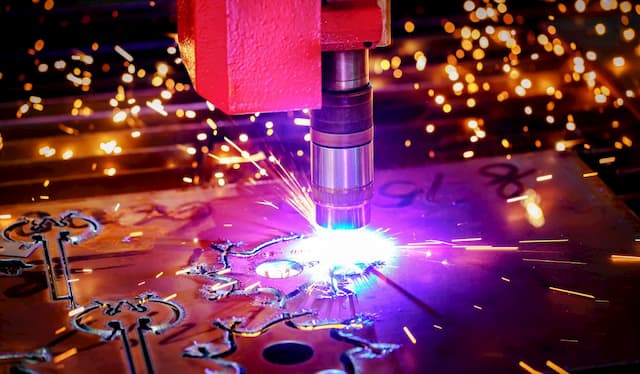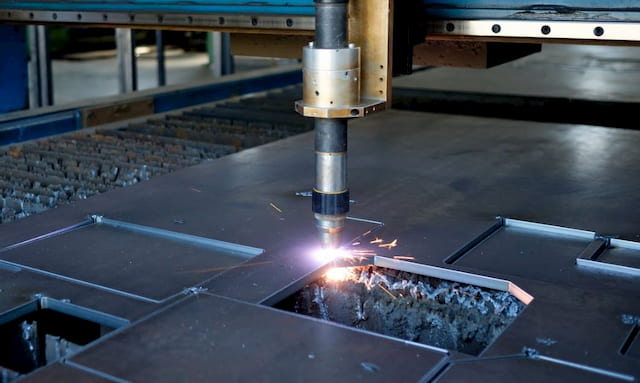Metal cutting can be categorised into two types: mechanical and thermal cutting. Plasma cutting is a thermal cutting method where ionised gas is used for cutting metal.
It is one of the most widely used techniques to cut thick metal plates, but is also available for sheet metal. Before diving into the advantages and capabilities of plasma cutting, we should tackle another question.
What Is Plasma?
You have definitely heard of the 3 fundamental states of matter – solid, liquid and gas. But there is a fourth one as well. Yes, it is plasma.
It is possible to find plasma in nature, but mainly in the upper parts of Earth’s atmosphere. The famous polar lights are a result of solar winds made of plasma. Lighting and high-temperature fire also include plasma. And so do our bodies.
Altogether, it makes up about 99% of the visible universe.
In our daily lives, we can encounter plasma in TVs, fluorescent lamps, neon signs and, of course, plasma cutters.
Plasma is an electrically conductive ionised gas-like substance. This means that some atoms are missing electrons and there are also free electrons floating around.
A gas can be transformed into plasma by subjecting it to intense heating. That is why plasma is often called an ionised gas.
Plasma is similar to gas as the atoms are not in constant contact with each other. At the same time, it behaves similarly to liquids in terms of its ability to flow when subjected to an electrical and magnetic field.
How Does a Plasma Cutter Work?
ARVE error: url: https://www.googleapis.com/youtube/v3/videos?part=snippet%2Cstatistics&id=e7xwhaSAAks&key=AIzaSyAQ7WFzTAUrOX-FjsIrFS3JwZBFzgIvloc Status code 200 expected but was 403.
The plasma cutting process is a thermal cutting method. This means that it uses heat to melt the metal instead of mechanically cutting it.
The overall mechanics of the system are always the same. Plasma cutters use compressed air or other gases, such as nitrogen. Ionisation of these gases takes place to create plasma.
Typically, the compressed gases come into contact with the electrode and then ionise to create more pressure. When the pressure builds up, a stream of plasma is pushed towards the cutting head.
The cutting tip constricts the flow to create a stream of plasma. This is then subjected to the workpiece. As plasma is electrically conductive, the workpiece is connected to the ground through the cutting table.
As the plasma arc contacts the metal, its high temperature melts it. At the same time, the high-speed gases blow away the molten metal.
Starting the Cutting Process
Not all systems work the same way. Firstly, there is a generally lower-budget version called high-frequency contact. This is not available for CNC plasma cutters because the high frequency can interfere with modern equipment and cause problems.
This method uses a high voltage and high-frequency spark. The creation of the spark takes place when the plasma torch touches the metal. This closes the circuit and creates the spark, which, in turn, creates plasma.

Another option is the pilot arc method. First, the spark is created inside the torch by a high-voltage and low-current circuit. The spark creates the pilot arc, which is a small amount of plasma.
The cutting arc gets created when the pilot arc is brought into contact with the workpiece. The operator can now start the cutting process.
A third way is using a spring-loaded plasma torch head. Pressing the torch against the workpiece creates a short circuit, which makes the current start to flow.
Releasing the pressure establishes the pilot arc. The following is the same as in the previous method. That is bringing the arc into contact with the workpiece.
Advantages & Disadvantages
Advantages
- Able to cut all conductive materials. Flame cutting, though also suitable for cutting thick metals, is limited to ferrous metals only.
- Great quality for thickness up to 50 mm.
- Maximum thickness up to 150 mm.
- Comparatively cheap for medium-thickness cuts.
- The best way to cut medium-thickness stainless steel and aluminium.
- CNC machines are available to provide high precision and repeatability.
- Can cut in water, resulting in smaller HAZ. Also reduces noise levels.
- Smaller cutting kerf compared to flame cutting.
- Quicker cutting speed than oxyfuel.
- By manipulating the parameters, the same machine can be used for plasma welding.
Disadvantages
- Larger HAZ compared to laser cutting.
- The quality of thinner sheets and plates is not as good as laser cutting.
- Tolerances are not as precise as laser cutting.
- Does not reach the thicknesses of flame or waterjet cutting.
- Leaves HAZ, which waterjet does not.
- Wider kerf than laser cutting.
- Personal account manager
- Quality assurance
- Payment terms for companies
- On-time delivery by Fractory
Choosing a Cutting Method
Making your choice between different cutting methods comes down to the material, its thickness and the application of the parts.
The recommended cutting thickness for plasma cutting is between 15…50 mm.
The recommended upper limit of material thickness for a plasma cutting service is about 50 mm for carbon and stainless steel. Aluminium should not go past 40 mm. Everything above that is in the domain of waterjet and flame cutting.
For manufacturers working with non-ferrous metals, understanding the nuances of plasma cutting aluminium, like proper gas selection, pierce settings, and cooling methods, helps achieve clean cuts and reduce post-processing time.
Laser cutting services should be the preferred option for sheet metal and thinner plates because greater cutting quality and speed. But laser cutting’s upper limit is somewhere around 25…30 mm.
Also, plasma cutting is quicker and therefore cheaper with plates starting from around 15 mm. Then again, the question comes down to the required quality. It is, though, always possible to get a nice and smooth result with post-processing.




